Thanks to their added versatility, bumper plates tend to reign supreme over metal plates for most home gym owners, and the Living.Fit Weight Plates are some of our favorites. Because of the rubber coating, you can drop these bumpers repeatedly without worrying about damaging your barbell or home gym floor during movements like a power clean. Living.Fit actually claims these plates can withstand up to 15,000 drops, so longevity shouldn’t be a concern.
These bumper plates from Living.Fit are available in individual pairs ranging from five to 45 pounds, and in full sets that range from 160 to 370 pounds. The color coding makes it easier to grab the weight you need and get right to your workout, and the alloy steel inserts are wrapped in a low-bounce rubber. While Living.Fit doesn’t provide the durometer rating — which determines the overall hardness of an object and how much bounce to expect — we experienced minimal bounce, so you don’t have to worry about your barbell bouncing back at you. We think these bumpers provide excellent value because of their durability and the variety of full sets available for purchase.
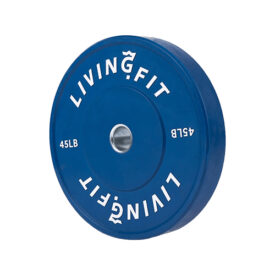
These high-quality bumper plates feature alloy steel inserts with a low-bounce rubber coating. With full sets ranging from 160 to 370-pounds, there is a solid chance most athletes can purchase a set that meets their needs.
Main Takeaways
- Living.Fit offers full sets ranging from 160 to 370 pounds.
- These plates pair alloy steel inserts with a low-bounce rubber coating and can withstand up to 15,000 drops.
- The color coding makes it easy to identify your plates on the fly.
Living.Fit Weight Plates Video Review
Our Reviews Writer, Jake, tested these bumper plates first hand in the BarBend Garage Gym. Follow along to his detailed video review as he breaks down everything you should know about them.
Living.Fit Weight Plates Highlights
- Price: Individual pairs range from $50 to $230. Full sets range from $400 to $940.
- Dimensions: IWF standard diameter of 17.7 inches; thickness depends on the weight, ranging from 0.8 inches to 2.9 inches.
- Materials: Alloy steel inserts and low-bounce rubber coating.
Money is often a big factor for those looking to build out a home gym, and weight plates can be pretty expensive — regardless of whether they’re bumper plates or metal plates. While these ones are fairly pricey compared to the rest of the market, their durability makes the cost worth it. However, if you’re just starting out on your fitness journey and don’t need more than 160 pounds, you can find a set for cheaper than $400.
When you’re searching for weight plates, their dimensions may not be at the forefront of your mind, but they’re quite important. These plates are pretty thick, which is nice for beginners who aren’t putting multiple plates on for their Olympic lifts, as that extra thickness will prevent the plates from bending. However, athletes stacking multiple plates on their bar may want to target some thinner ones so they can fit more weight.

The durability of these plates comes from the materials used in the design process — especially that of the inserts. Living.Fit uses alloy steel for the inserts (aka the strongest steel). And while they didn’t disclose if they used a virgin rubber coating, these plates passed the eye and drop test.
Pros
- The rubber coating allows you to incorporate Olympic and CrossFit exercises into your workout routine in addition to powerlifting exercises, like bench pressing.
- The color coding adds a nice aesthetic to these plates and makes grabbing the ones you need for each workout easier.
- The wide range of full sets available for purchase allows all athletes to find what they specifically want and need to reach their goals.
Cons
- These plates are pricey compared to the rest of the market.
- The thickness may negatively impact the whip of your barbell during explosive movements, like a hang clean.
- Living.Fit does not disclose the durometer rating or the type of rubber used.
Training With the Living.Fit Weight Plates
We really enjoyed our time with the Living.Fit Weight Plates. They meet the IWF diameter standard of 17.7 inches, but they’re thicker than competition bumpers. The dead bounce from the rubber coating is a nice touch, as it prevents the bar from bouncing back into your body when dropped, and the color coding adds to the aesthetic appeal.
Bounce
Since bumper plates are designed to be dropped repeatedly, it’s important to note how much bounce occurs when dropped. While some Olympic and CrossFit athletes may opt for crumb bumper plates, the extra bounce might mess with your mojo. Metal plates don’t feature much bounce whatsoever, but they also don’t offer any shock absorption.
This is where bumper plates like these come into play. They offer a “dead bounce,” which is exactly how it sounds — when you drop your barbell, they’ll absorb the shock and keep the bounce to a minimum. These plates fall into that category, making them a solid option for all your lifts.
Dimensions
While the weight determines the thickness of these bumper plates, the diameter is uniform — aside from the five-pound change plates — measuring 17.7 inches, which is the IWF standard. The five-pound plates are smaller in diameter because this keeps them from bending or “tacoing” over time when dropped.
The 10-pound plates are 22mm thick, the 15’s are 30mm thick, the 25s are 43mm thick, the 35s are 60.5mm thick, and the 45s are 74mm thick. These are thicker than a competition plate, so they don’t meet the IWF standards. Since they’re on the thicker end of the spectrum, those attempting to set a world record may want to opt for thinner ones that allow you to pack on more plates.
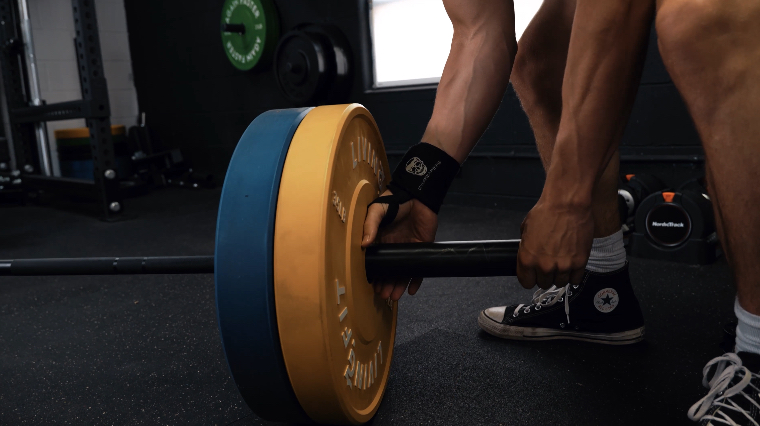
Another thing to consider is that these plates’ overall thickness may impact the bar’s whip during an exercise like the clean & jerk. However, beginners who aren’t lifting a bunch of weight may find this helpful, as the extra thickness will protect the plates from bending.
Color and Labeling
These bumper plates from Living.Fit are color-coded based on the weight.
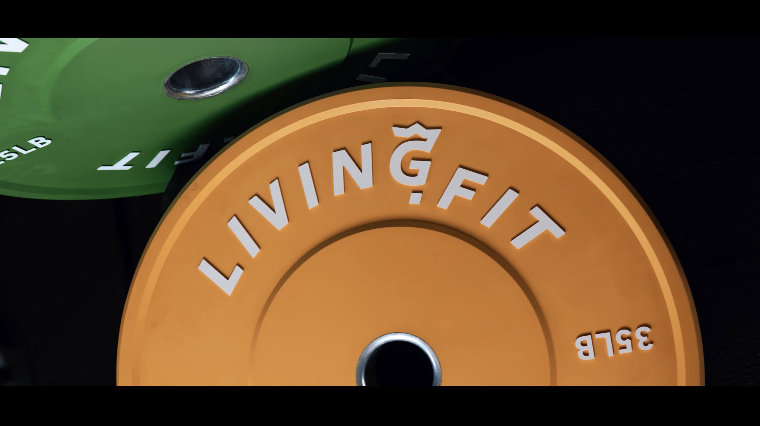
While this doesn’t change the way the plates function by any means, it can make grabbing the weight you need for your workout effortless.
What to Consider Before Buying the Living.Fit Weight Plates
Like all home gym essentials, there are a couple of factors you need to consider with these bumper plates. Money is often the biggest factor for some people, but you also need to be aware of the various weight options, and whether or not these particular plates are ideal for your preferred workout style.
Price and Weight Options
The base price for these bumper plates is pretty pricey compared to the competition, but since shipping is free, it balances out a bit. For individual pairs, the five-pound plates are about $50, the 10s are roughly $70, the 15s are about $80, the 25s are around $130, the 35s are about $190, and the 45s are nearly $230.
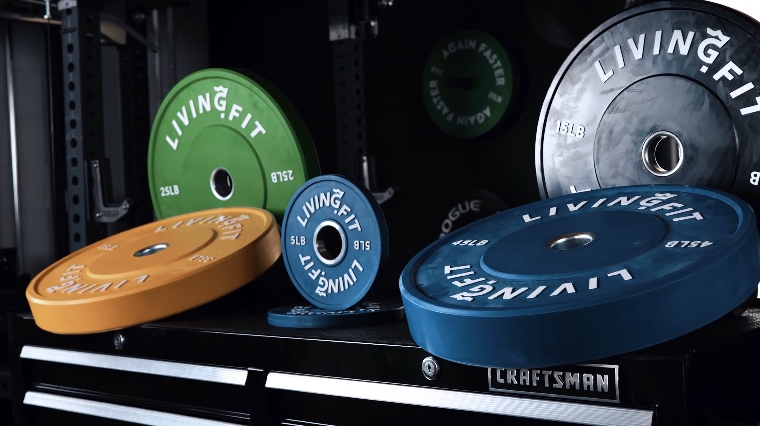
The full sets are the best way to get the most out of your purchase. And the beauty about these plates, in particular, is that there are nine options ranging from 160 pounds to 370 pounds. The 160-pound set is about $400, the 260-pound set is roughly $660, and the 370-pound set will run around $940.
The wide range of full sets is a massive plus in our eyes, as it opens the door for most athletes to find an option that coincides with their strength needs. And while we think the overall quality of these plates makes them worthy of their price tag, you can find some cheaper options elsewhere on the market if you want to keep your finances a little tighter.
Workout Style
While bumper plates work well across all of your lifts, the extra money you’ll spend on these might not be worth it for those who are only powerlifting.
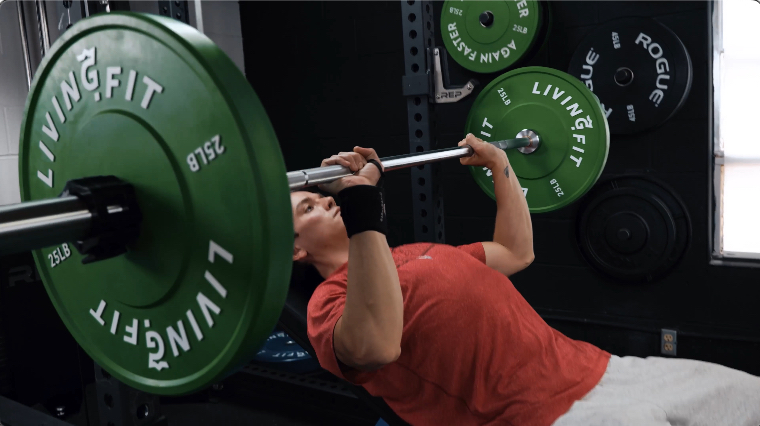
So if you are, in fact, a dedicated powerlifter who only focuses on the big three — squat, bench, and deadlift — then you’ll likely be better off with some standard metal plates.
Living.Fit Weight Plates Vs. Competitor Bumper Plates
While you may not realize it, bumper plates tend to vary in their thickness, durometer rating, materials used, and the amount of weight available for purchase. Since there are too many bumper plates to compare all of them, we figured we’d pin these plates from Living.Fit against some of our favorite colored and non-colored bumpers on the market.
| Living.Fit Weight Plates | Again Faster Evolution Color Bumper Plates | Rogue Echo Bumper Plates | REP Fitness Black Bumper Plates | |
| Price (260-pound set) | $660 | $699 | $555 | $593 |
| Thickness (45-pound plates) | 2.9 inches | 2.9 inches | 2.4 inches | 2.8 inches |
| Durometer Rating | N/A | 90 | 88 | N/A |
| Materials | Alloy steel and virgin rubber | Stainless steel and virgin rubber | Stainless steel and virgin rubber | Steel with virgin rubber |
| Heaviest Set | 370 pounds | 1,000 pounds | 260 pounds | 340 pounds |
We decided to compare the 260-pound sets because this is a solid weight range for the average gymgoer. So if you’re looking for the “cheapest” option, the Rogue Echo Bumpers will be the way to go.
Anyone looking to pack on the most weight possible also may want to lean toward the Echo’s since they’re the thinnest option by a long shot. However, beginners who are only tossing one or two plates on may want to consider one of the other options since they’ll absorb shock at a higher rate. While all of these plates feature a virgin rubber coating, the Living.Fit plates are the only ones that use alloy steel. This form of steel is known to be stronger and more durable, meaning these plates will likely be able to withstand more punishment in the long run.
Those who want to add as many plates to their home gym as possible must keep in mind the heaviest options available to avoid making multiple purchases. And since the durometer rating is a pretty important factor, knowing exactly what to expect from your bumpers is nice. Although we have personally tested all of these bumper plates and found them to be comparable in this regard, we understand why some people may lean towards the Again Faster Evo Bumpers and Rogue since the Living.Fit and REP bumpers don’t have that information listed.
At the end of the day, nobody knows what’s best for you and your needs better than you. We just want to steer you in the right direction. We enjoy all of these plates for a reason, but one may simply be “better” for you specifically.
Places to Buy
You can purchase the Living.Fit Weight Plates directly through the Living.Fit website.
Warranties
Living.Fit offers a four-year warranty for at-home usage and a one-year warranty for commercial usage.
Company Information
Living.Fit manufactures a wide range of strength equipment, as well as workout plans and courses you can follow. If you need to reach a team member, you can email them at info@living.fit, or via phone at 844-524-0677.
In Conclusion
Living.Fit has gained some steam in the fitness industry, and their bumpers are no exception. The alloy steel inserts can take a beating, the low-bounce rubber offers a dead bounce, and the wide range of weight options opens the door for most athletes to find a solution that aligns with their needs. While they may be a little more expensive than some of the competition, we think the overall quality makes them worthy of that price tag and that they’ll provide excellent value in your gym for nearly a decade.
FAQs
How much do the Living.Fit Weight Plates cost?
You can purchase these bumper plates in pairs or as a full set. A five-pound pair will run you around $50, the 10s are about $70, the 15s are around $80, the 25s will cost you roughly $130, the 35s are about $190, and the 45s are about $230.
The 160-pound set is the cheapest of the nine sets and will cost you around $400. The 260-pound set is about $660, and the 370-pound set will run you around $940.
What workouts can I do with the Living.Fit Weight Plates?
The beauty of these bumper plates is that they can be used across all your lifts. So whether you want to focus on powerlifting, or Olympic and CrossFit lifts, they can do it all.
Does the thickness of the Living.Fit Weight Plates matter?
The thickness of the plates matters to all athletes but in different ways, and their thickness is average compared to the rest of the market. However, experienced athletes who put up impressive numbers will likely want to find some thinner plates, so they can load on more weight without negatively impacting the whip of their barbell.